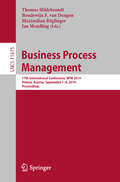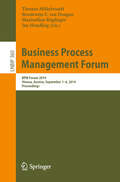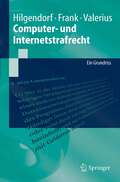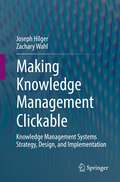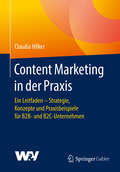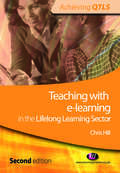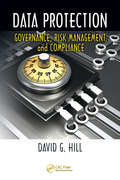- Table View
- List View
Law for Computer Scientists and Other Folk
by Mireille HildebrandtThis is the first textbook introducing law to computer scientists. The book covers privacy and data protection law, cybercrime, intellectual property, private law liability and legal personhood and legal agency, next to introductions to private law, public law, criminal law and international and supranational law. It provides an overview of the practical implications of law, their theoretical underpinnings and how they affect the study and construction of computational architectures. In a constitutional democracy everyone is under the Rule of Law, including those who develop code and systems, and those who put applications on the market. It is pivotal that computer scientists and developers get to know what law and the Rule of Law require. Before talking about ethics, we need to make sure that the checks and balances of law and the Rule of Law are in place and complied with. Though it is focused on European law, it also refers to US law and aims to provide insights into what makes law, law, rather than brute force or morality, demonstrating the operations of law in a way that has global relevance. This book is geared to those who have no wish to become lawyers but are nevertheless forced to consider the salience of legal rights and obligations with regard to the construction, maintenance and protection of computational artefacts. This is an open access title available under the terms of a CC BY-NC-ND 4.0 International licence. It is offered as a free PDF download from OUP and selected open access locations.
Law for Computer Scientists and Other Folk
by Mireille HildebrandtThis is the first textbook introducing law to computer scientists. The book covers privacy and data protection law, cybercrime, intellectual property, private law liability and legal personhood and legal agency, next to introductions to private law, public law, criminal law and international and supranational law. It provides an overview of the practical implications of law, their theoretical underpinnings and how they affect the study and construction of computational architectures. In a constitutional democracy everyone is under the Rule of Law, including those who develop code and systems, and those who put applications on the market. It is pivotal that computer scientists and developers get to know what law and the Rule of Law require. Before talking about ethics, we need to make sure that the checks and balances of law and the Rule of Law are in place and complied with. Though it is focused on European law, it also refers to US law and aims to provide insights into what makes law, law, rather than brute force or morality, demonstrating the operations of law in a way that has global relevance. This book is geared to those who have no wish to become lawyers but are nevertheless forced to consider the salience of legal rights and obligations with regard to the construction, maintenance and protection of computational artefacts. This is an open access title available under the terms of a CC BY-NC-ND 4.0 International licence. It is offered as a free PDF download from OUP and selected open access locations.
Information, Freedom and Property: The Philosophy of Law Meets the Philosophy of Technology
by Mireille Hildebrandt Bibi Van Den BergThis book addresses issues on the nexus of freedom of and property in information, while acknowledging that both hiding and exposing information may affect our privacy. It inquires into the physics, the technologies, the business models, the governmental strategies and last but not least the legal frameworks concerning access, organisation and control of information. It debates whether it is in the very nature of information to be either free or monopolized, or both. Analysing upcoming power structures, new types of colonization and attempts to replace legal norms with techno-nudging, this book also presents the idea of an infra-ethics capable of pre-empting our pre-emption. It discusses the interrelations between open access, the hacker ethos, the personal data economy, and freedom of information, highlighting the ephemeral but pivotal role played by information in a data-driven society. This book is a must-read for those working on the contemporary dimensions of freedom of information, data protection, and intellectual property rights.
Information, Freedom and Property: The Philosophy of Law Meets the Philosophy of Technology
by Mireille Hildebrandt Bibi van den BergThis book addresses issues on the nexus of freedom of and property in information, while acknowledging that both hiding and exposing information may affect our privacy. It inquires into the physics, the technologies, the business models, the governmental strategies and last but not least the legal frameworks concerning access, organisation and control of information. It debates whether it is in the very nature of information to be either free or monopolized, or both. Analysing upcoming power structures, new types of colonization and attempts to replace legal norms with techno-nudging, this book also presents the idea of an infra-ethics capable of pre-empting our pre-emption. It discusses the interrelations between open access, the hacker ethos, the personal data economy, and freedom of information, highlighting the ephemeral but pivotal role played by information in a data-driven society. This book is a must-read for those working on the contemporary dimensions of freedom of information, data protection, and intellectual property rights.
Profiling the European Citizen: Cross-Disciplinary Perspectives
by Mireille Hildebrandt Serge GutwirthIn the eyes of many, one of the most challenging problems of the information society is that we are faced with an ever expanding mass of information. Based on the work done within the European Network of Excellence (NoE) on the Future of Identity in Information Society (FIDIS), a set of authors from different disciplinary backgrounds and jurisdictions share their understanding of profiling as a technology that may be preconditional for the future of our information society.
Business Process Management: 17th International Conference, BPM 2019, Vienna, Austria, September 1–6, 2019, Proceedings (Lecture Notes in Computer Science #11675)
by Thomas Hildebrandt Boudewijn F. van Dongen Maximilian Röglinger Jan MendlingThis book constitutes the proceedings of the 17th International Conference on Business Process Management, BPM 2019, held in Vienna, Austria, in September 2019. The 23 full and 4 tutorial short papers included in this volume were carefully reviewed and selected from 115 submissions. The papers were organized in topical sections named: foundations; engineering; and management.
Business Process Management Forum: BPM Forum 2019, Vienna, Austria, September 1–6, 2019, Proceedings (Lecture Notes in Business Information Processing #360)
by Thomas Hildebrandt Boudewijn F. van Dongen Maximilian Röglinger Jan MendlingThis book constitutes the proceedings of the BPM Forum held during the 17th International Conference on Business Process Management, BPM 2019, which took place in Vienna, Austria, in September 2019. The BPM Forum hosts innovative research which has a high potential of stimulating discussions. The papers selected for the forum are expected to showcase fresh ideas from exciting and emerging topics in BPM, even if they are not yet as mature as the regular papers at the conference. The 13 full papers included in this volume were carefully reviewed and selected from a total of 115 submissions. The papers were organized in topical sections named: specification; execution; analytics; and management.
Web Services, Formal Methods, and Behavioral Types: 11th International Workshop, WS-FM 2014, Eindhoven, The Netherlands, September 11-12, 2014, and 12th International Workshop, WS-FM/BEAT 2015, Madrid, Spain, September 4-5, 2015, Revised Selected Papers (Lecture Notes in Computer Science #9421)
by Thomas Hildebrandt António Ravara Jan Martijn van der Werf Matthias WeidlichThis volume contains the refereed joint proceedings of two initiatives that have been devoted to the formal foundations of complex systems: the workshops WS-FM:FASOCC 2014 and WS-FM/BEAT 2015. The 11th International Workshop on Web Services and Formal Methods: Formal Aspects of Services-Oriented and Cloud Computing, WS-FM 2014, took place in Eindhoven, The Netherlands, in September 2014. The 12th International Workshop on Web Services, Formal Methods, and Behavioral Types, WS-FM 2015, took place in Madrid, Spain, in September 2015. The total of 8 papers presented in this volume was carefully reviewed and selected from 18 submissions. They were organized in topical sections named: expressiveness of behavioral models; service-oriented systems, and behavioral types.
Foundations of Geometric Algebra Computing (Geometry and Computing #8)
by Dietmar HildenbrandThe author defines “Geometric Algebra Computing” as the geometrically intuitive development of algorithms using geometric algebra with a focus on their efficient implementation, and the goal of this book is to lay the foundations for the widespread use of geometric algebra as a powerful, intuitive mathematical language for engineering applications in academia and industry. The related technology is driven by the invention of conformal geometric algebra as a 5D extension of the 4D projective geometric algebra and by the recent progress in parallel processing, and with the specific conformal geometric algebra there is a growing community in recent years applying geometric algebra to applications in computer vision, computer graphics, and robotics.This book is organized into three parts: in Part I the author focuses on the mathematical foundations; in Part II he explains the interactive handling of geometric algebra; and in Part III he deals with computing technology for high-performance implementations based on geometric algebra as a domain-specific language in standard programming languages such as C++ and OpenCL. The book is written in a tutorial style and readers should gain experience with the associated freely available software packages and applications.The book is suitable for students, engineers, and researchers in computer science, computational engineering, and mathematics.
Introduction to Geometric Algebra Computing
by Dietmar HildenbrandFrom the Foreword: "Dietmar Hildenbrand's new book, Introduction to Geometric Algebra Computing, in my view, fills an important gap in Clifford's geometric algebra literature…I can only congratulate the author for the daring simplicity of his novel educational approach taken in this book, consequently combined with hands on computer based exploration. Without noticing, the active reader will thus educate himself in elementary geometric algebra algorithm development, geometrically intuitive, highly comprehensible, and fully optimized." --Eckhard Hitzer, International Christian University, Tokyo, Japan Geometric Algebra is a very powerful mathematical system for an easy and intuitive treatment of geometry, but the community working with it is still very small. The main goal of this book is to close this gap with an introduction to Geometric Algebra from an engineering/computing perspective. This book is intended to give a rapid introduction to computing with Geometric Algebra and its power for geometric modeling. From the geometric objects point of view, it focuses on the most basic ones, namely points, lines and circles. This algebra is called Compass Ruler Algebra, since it is comparable to working with a compass and ruler. The book explores how to compute with these geometric objects, and their geometric operations and transformations, in a very intuitive way. The book follows a top-down approach, and while it focuses on 2D, it is also easily expandable to 3D computations. Algebra in engineering applications such as computer graphics, computer vision and robotics are also covered.
Introduction to Geometric Algebra Computing
by Dietmar HildenbrandFrom the Foreword: "Dietmar Hildenbrand's new book, Introduction to Geometric Algebra Computing, in my view, fills an important gap in Clifford's geometric algebra literature…I can only congratulate the author for the daring simplicity of his novel educational approach taken in this book, consequently combined with hands on computer based exploration. Without noticing, the active reader will thus educate himself in elementary geometric algebra algorithm development, geometrically intuitive, highly comprehensible, and fully optimized." --Eckhard Hitzer, International Christian University, Tokyo, Japan Geometric Algebra is a very powerful mathematical system for an easy and intuitive treatment of geometry, but the community working with it is still very small. The main goal of this book is to close this gap with an introduction to Geometric Algebra from an engineering/computing perspective. This book is intended to give a rapid introduction to computing with Geometric Algebra and its power for geometric modeling. From the geometric objects point of view, it focuses on the most basic ones, namely points, lines and circles. This algebra is called Compass Ruler Algebra, since it is comparable to working with a compass and ruler. The book explores how to compute with these geometric objects, and their geometric operations and transformations, in a very intuitive way. The book follows a top-down approach, and while it focuses on 2D, it is also easily expandable to 3D computations. Algebra in engineering applications such as computer graphics, computer vision and robotics are also covered.
The Power of Geometric Algebra Computing: For Engineering and Quantum Computing
by Dietmar HildenbrandGeometric Algebra is a very powerful mathematical system for an easy and intuitive treatment of geometry, but the community working with it is still very small. The main goal of this book is to close this gap from a computing perspective in presenting the power of Geometric Algebra Computing for engineering applications and quantum computing. The Power of Geometric Algebra Computing is based on GAALOPWeb, a new user-friendly, web-based tool for the generation of optimized code for different programming languages as well as for the visualization of Geometric Algebra algorithms for a wide range of engineering applications. Key Features: Introduces a new web-based optimizer for Geometric Algebra algorithms Supports many programming languages as well as hardware Covers the advantages of high-dimensional algebras Includes geometrically intuitive support of quantum computing This book includes applications from the fields of computer graphics, robotics and quantum computing and will help students, engineers and researchers interested in really computing with Geometric Algebra.
The Power of Geometric Algebra Computing: For Engineering and Quantum Computing
by Dietmar HildenbrandGeometric Algebra is a very powerful mathematical system for an easy and intuitive treatment of geometry, but the community working with it is still very small. The main goal of this book is to close this gap from a computing perspective in presenting the power of Geometric Algebra Computing for engineering applications and quantum computing. The Power of Geometric Algebra Computing is based on GAALOPWeb, a new user-friendly, web-based tool for the generation of optimized code for different programming languages as well as for the visualization of Geometric Algebra algorithms for a wide range of engineering applications. Key Features: Introduces a new web-based optimizer for Geometric Algebra algorithms Supports many programming languages as well as hardware Covers the advantages of high-dimensional algebras Includes geometrically intuitive support of quantum computing This book includes applications from the fields of computer graphics, robotics and quantum computing and will help students, engineers and researchers interested in really computing with Geometric Algebra.
Knowledge Discovery and Measures of Interest (The Springer International Series in Engineering and Computer Science #638)
by Robert J. Hilderman Howard J. HamiltonKnowledge Discovery and Measures of Interest is a reference book for knowledge discovery researchers, practitioners, and students. The knowledge discovery researcher will find that the material provides a theoretical foundation for measures of interest in data mining applications where diversity measures are used to rank summaries generated from databases. The knowledge discovery practitioner will find solid empirical evidence on which to base decisions regarding the choice of measures in data mining applications. The knowledge discovery student in a senior undergraduate or graduate course in databases and data mining will find the book is a good introduction to the concepts and techniques of measures of interest. In Knowledge Discovery and Measures of Interest, we study two closely related steps in any knowledge discovery system: the generation of discovered knowledge; and the interpretation and evaluation of discovered knowledge. In the generation step, we study data summarization, where a single dataset can be generalized in many different ways and to many different levels of granularity according to domain generalization graphs. In the interpretation and evaluation step, we study diversity measures as heuristics for ranking the interestingness of the summaries generated. The objective of this work is to introduce and evaluate a technique for ranking the interestingness of discovered patterns in data. It consists of four primary goals: To introduce domain generalization graphs for describing and guiding the generation of summaries from databases. To introduce and evaluate serial and parallel algorithms that traverse the domain generalization space described by the domain generalization graphs. To introduce and evaluate diversity measures as heuristic measures of interestingness for ranking summaries generated from databases. To develop the preliminary foundation for a theory of interestingness within the context of ranking summaries generated from databases. Knowledge Discovery and Measures of Interest is suitable as a secondary text in a graduate level course and as a reference for researchers and practitioners in industry.
Computer- und Internetstrafrecht: Ein Grundriss (Springer-Lehrbuch)
by Eric Hilgendorf Thomas Frank Brian ValeriusDie moderne Informations- und Kommunikationstechnologie stellt das Recht vor neue Herausforderungen. Das Lehrbuch vermittelt einen umfassenden und zugleich detaillierten Überblick über das Computer- und Internetstrafrecht, angefangen vom klassischen Computerbetrug und Hacking von Daten bis hin zu den jüngsten kriminellen Erscheinungsformen wie Domain-Hijacking und Phishing. Darüber hinaus widmet es sich auch künftigen Entwicklungen, vor allem der zunehmenden Internationalisierung des Rechts auf diesem Gebiet.
Making Knowledge Management Clickable: Knowledge Management Systems Strategy, Design, and Implementation
by Joseph Hilger Zachary WahlThis book bridges the gap between knowledge management and technology. It embraces the complete lifecycle of knowledge, information, and data from how knowledge flows through an organization to how end users want to handle it and experience it. Whether your intent is to design and implement a single technology or a complete collection of KM systems, this book provides the foundations necessary for success. It will help you understand your organization’s needs and opportunities, strategize and prioritize features and functions, design with the end user in mind, and finally build a system that your users will embrace and which will realize meaningful business value for your organization. The book is the culmination of the authors’ collective careers, a combined sixty years of experience doing exactly what is detailed in this book. Their guidance has been honed by their own successes and failures as well as many others they have researched in order to provide a comprehensive study on KM transformations and the technologies that help to enable them. They have successfully applied this knowledge as the founders and leaders of the world’s largest dedicated knowledge management consultancy, which runs these projects for many of the world’s most complex organizations. They are writing as practitioners directly to other practitioners with the intent to enable them to apply and benefit from their knowledge and experience.“Compelling reading for KM practitioners looking to ensure their technology decisions support their business and organizational objectives.” - Margot Brown, Director of Knowledge Management, World Bank Group "We are two years into our KM Transformation and if I’d had this book beforehand, it would have made the journey smoother and faster! This is a great playbook for how to plan, organize, and execute a KM transformation." - Stephanie Hill, Senior Director, Global Customer Services, PayPal
Einführung in die Medizinische Statistik (Statistik und ihre Anwendungen)
by Ralf-Dieter Hilgers Peter Bauer Viktor ScheiberDie speziellen Probeme der Datenanalyse im Bereich der medizinischen Forschung erfordern ein besonderes Verständnis statistischer Methoden. Das vorliegende Buch führt systematisch und umfassend in diese Methoden sowie deren Terminologie ein. Es entspricht dem aktuellen Gegenstandskatalog für Biometrie in der Ausbildung für Mediziner. Die Darstellung der theoretischen Konzepte wird durch zahlreiche Abbildungen und medizinische Beispiele veranschaulicht. MC-orientierte Übungsaufgaben mit Lösungen helfen dem Leser, das erlernte Wissen zu vertiefen.
Content Marketing in der Praxis: Ein Leitfaden - Strategie, Konzepte und Praxisbeispiele für B2B- und B2C-Unternehmen
by Claudia HilkerDieses Fachbuch zeigt konkret, wie die neue Kommunikationsform Content-Marketing erfolgreich im Unternehmen implementiert werden kann. Es werden die Voraussetzungen geklärt sowie ein praktikabler Leitfaden zur Umsetzung entwickelt. Best-Practice-Beispiele aus einer Vielzahl von Branchen veranschaulichen den Weg, wie dieser neuer Vermarktungs-Ansatz, der die Inhalte und Kompetenzen des Produktanbieters in den Vordergrund stellt, die Marketing- und Sales-Kommunikation erfolgreich beleben kann.
Blockchain Quick Reference: A guide to exploring decentralized blockchain application development
by Brenn Hill Samanyu Chopra Paul ValencourtUnderstand the Blockchain revolution and get to grips with Ethereum, Hyperledger Fabric, and Corda.Key FeaturesResolve common challenges and problems faced in the Blockchain domainStudy architecture, concepts, terminologies, and DappsMake smart choices using Blockchain for personal and business investmentsBook DescriptionBlockchain Quick Reference takes you through the electrifying world of blockchain technology and is designed for those who want to polish their existing knowledge regarding the various pillars of the blockchain ecosystem.This book is your go-to guide, teaching you how to apply principles and ideas for making your life and business better. You will cover the architecture, Initial Coin Offerings (ICOs), tokens, smart contracts, and terminologies of the blockchain technology, before studying how they work. All you need is a curious mind to get started with blockchain technology. Once you have grasped the basics, you will explore components of Ethereum, such as ether tokens, transactions, and smart contracts, in order to build simple Dapps. You will then move on to learning why Solidity is used specifically for Ethereum-based projects, followed by exploring different types of blockchain with easy-to-follow examples. All this will help you tackle challenges and problems. By the end of this book, you will not only have solved current and future problems relating to blockchain technology but will also be able to build efficient decentralized applications.What you will learnUnderstand how blockchain architecture components workAcquaint yourself with cryptography and the mechanics behind blockchainApply consensus protocol to determine the business sustainabilityUnderstand what ICOs and crypto-mining are and how they workCreate cryptocurrency wallets and coins for transaction mechanismsUnderstand the use of Ethereum for smart contract and DApp developmentWho this book is forBlockchain Quick Reference is for you if you are a developer who wants to get well-versed with blockchain and its associated concepts and terminologies. You will explore the working mechanism of a decentralized application with the help of examples. Business leaders and blockchain enthusiasts will also find this book useful, as it will help you effectively address challenges and make better personal and business investments.
Blockchain Quick Reference: A guide to exploring decentralized blockchain application development
by Brenn Hill Samanyu Chopra Paul ValencourtUnderstand the Blockchain revolution and get to grips with Ethereum, Hyperledger Fabric, and Corda.Key FeaturesResolve common challenges and problems faced in the Blockchain domainStudy architecture, concepts, terminologies, and DappsMake smart choices using Blockchain for personal and business investmentsBook DescriptionBlockchain Quick Reference takes you through the electrifying world of blockchain technology and is designed for those who want to polish their existing knowledge regarding the various pillars of the blockchain ecosystem.This book is your go-to guide, teaching you how to apply principles and ideas for making your life and business better. You will cover the architecture, Initial Coin Offerings (ICOs), tokens, smart contracts, and terminologies of the blockchain technology, before studying how they work. All you need is a curious mind to get started with blockchain technology. Once you have grasped the basics, you will explore components of Ethereum, such as ether tokens, transactions, and smart contracts, in order to build simple Dapps. You will then move on to learning why Solidity is used specifically for Ethereum-based projects, followed by exploring different types of blockchain with easy-to-follow examples. All this will help you tackle challenges and problems. By the end of this book, you will not only have solved current and future problems relating to blockchain technology but will also be able to build efficient decentralized applications.What you will learnUnderstand how blockchain architecture components workAcquaint yourself with cryptography and the mechanics behind blockchainApply consensus protocol to determine the business sustainabilityUnderstand what ICOs and crypto-mining are and how they workCreate cryptocurrency wallets and coins for transaction mechanismsUnderstand the use of Ethereum for smart contract and DApp developmentWho this book is forBlockchain Quick Reference is for you if you are a developer who wants to get well-versed with blockchain and its associated concepts and terminologies. You will explore the working mechanism of a decentralized application with the help of examples. Business leaders and blockchain enthusiasts will also find this book useful, as it will help you effectively address challenges and make better personal and business investments.
Teaching with e-learning in the Lifelong Learning Sector
by Chris HillThis new edition (previously entitled "Teaching Using Information and Learning Technology in Further Education") is an up to date resource for trainee and qualified teachers within the Lifelong Learning Sector. Focusing on information and learning technology as a toolkit for resourceful teachers, it includes reflective activities, teaching strategies and teaching tips throughout, along with ideas for applying these to the reader's own context. In this new edition, all material has been fully updated to reflect the latest changes in technology and its applications, and each chapter in the book is referenced to the new LLUK Standards.
Data Protection: Governance, Risk Management, and Compliance
by David G. HillFailure to appreciate the full dimensions of data protection can lead to poor data protection management, costly resource allocation issues, and exposure to unnecessary risks. Data Protection: Governance, Risk Management, and Compliance explains how to gain a handle on the vital aspects of data protection.The author begins by building the foundatio
Data Protection: Governance, Risk Management, and Compliance
by David G. HillFailure to appreciate the full dimensions of data protection can lead to poor data protection management, costly resource allocation issues, and exposure to unnecessary risks. Data Protection: Governance, Risk Management, and Compliance explains how to gain a handle on the vital aspects of data protection.The author begins by building the foundatio
Multi-Level Simulation for VLSI Design (The Springer International Series in Engineering and Computer Science #18)
by D.D. Hill D.R. CoelhoAND BACKGROUND 1. 1 CAD, Specification and Simulation Computer Aided Design (CAD) is today a widely used expression referring to the study of ways in which computers can be used to expedite the design process. This can include the design of physical systems, architectural environments, manufacturing processes, and many other areas. This book concentrates on one area of CAD: the design of computer systems. Within this area, it focusses on just two aspects of computer design, the specification and the simulation of digital systems. VLSI design requires support in many other CAD areas, induding automatic layout. IC fabrication analysis, test generation, and others. The problem of specification is unique, however, in that it i!> often the first one encountered in large chip designs, and one that is unlikely ever to be completely automated. This is true because until a design's objectives are specified in a machine-readable form, there is no way for other CAD tools to verify that the target system meets them. And unless the specifications can be simulated, it is unlikely that designers will have confidence in them, since specifications are potentially erroneous themselves. (In this context the term target system refers to the hardware and/or software that will ultimately be fabricated. ) On the other hand, since the functionality of a VLSI chip is ultimately determined by its layout geometry, one might question the need for CAD tools that work with areas other than layout.
The Complete Project Management Methodology and Toolkit
by Gerard M. HillIn the past, an organization's technical methodologies were expected to fulfill project management process needs. However, they sometimes fell short of applying what is known today as "professional project management" concepts and practices. Written by one of the nation's most highly regarded project management mentors, The Complete Project Managem



